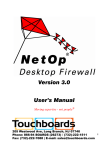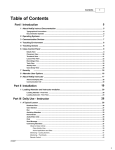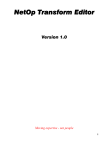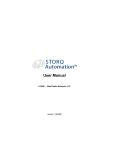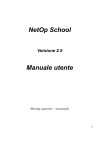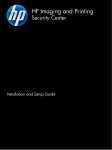Download Version 3.0 Quick Guide
Transcript
Version 3.0
Quick Guide
Moving expertise - not people®
Copyright© 1981-2005 Danware Data A/S. All Rights Reserved.
Portions used under license from third parties.
Document revision: 2004313
Please send comments to:
CrossTec Corp.
500 NE Spanish River Blvd. Suite 201
Boca Raton, FL 33431
USA
Toll Free 1-800-675-0729
E-mail: info@crossteccorp.com
http://www.crossteccorp.com
Contents
Contents. . . . . . . . . . . . . . . . . . . . . . . . . . . . . . . . . . . . . . . . . . . . . . . . 2
Welcome . . . . . . . . . . . . . . . . . . . . . . . . . . . . . . . . . . . . . . . . . . . . . . . 3
NetOp Policy Server Overview. . . . . . . . . . . . . . . . . . . . . . . . . . . . . . . 3
Documentation . . . . . . . . . . . . . . . . . . . . . . . . . . . . . . . . . . . . . . . . . . . 5
Updates . . . . . . . . . . . . . . . . . . . . . . . . . . . . . . . . . . . . . . . . . . . . . . . . 5
Install . . . . . . . . . . . . . . . . . . . . . . . . . . . . . . . . . . . . . . . . . . . . . . . . . . 5
Open NetOp Policy Server Console. . . . . . . . . . . . . . . . . . . . . . . . . . 13
NetOp Policy Server Console . . . . . . . . . . . . . . . . . . . . . . . . . . . . . . 21
Manage Security Policies . . . . . . . . . . . . . . . . . . . . . . . . . . . . . . . 22
Tools . . . . . . . . . . . . . . . . . . . . . . . . . . . . . . . . . . . . . . . . . . . . . . . . . 24
Manage Servers . . . . . . . . . . . . . . . . . . . . . . . . . . . . . . . . . . . . . . 24
Manage Firewall Logons . . . . . . . . . . . . . . . . . . . . . . . . . . . . . . . 25
Manage Administrators . . . . . . . . . . . . . . . . . . . . . . . . . . . . . . . . 26
Other Tools. . . . . . . . . . . . . . . . . . . . . . . . . . . . . . . . . . . . . . . . . . 27
NetOp Policy Server Communication. . . . . . . . . . . . . . . . . . . . . . . . . 29
2
Welcome
Welcome
Welcome to NetOp Policy Server from Danware.
This Quick Guide provides a NetOp Policy Server overview and guides
you through initial installation and startup.
NetOp Product Services
NetOp Policy Server Overview
NetOp Policy Server includes the modules NetOp Policy Server
Console, Master Server and Replica Server.
3
NetOp Policy Server Overview
NetOp Policy Server Console is the main user interface from which an
administrator can control a Master Server. NetOp Policy Server
Console is typically installed on a system or network administrator
workstation.
Master Server stores Security Policies, controls which Security Policy
is assigned to each NetOp Desktop Firewall and stores records of
interaction with NetOp Desktop Firewalls.
Master Server interacts with NetOp Desktop Firewalls only through a
cluster of up to 32 Replica Servers.
One Master Server is typically installed on each local area network on
a server computer that must run almost continuously with only short
downtime periods.
A Master Server and its cluster of Replica Servers operate jointly to
appear at the Console end as well as at the NetOp Desktop Firewall
end as one NetOp Policy Server and can be designated as such as
illustrated in the image above.
Replica Servers interact with NetOp Desktop Firewalls and record
interaction. Replica Servers should be installed in different parts of a
local area network for proximity to NetOp Desktop Firewalls. Each
Replica Server can service up to several thousands NetOp Desktop
Firewalls.
At least one Replica Server should be available at all times to service
NetOp Desktop Firewall requests. If there are multiple Replica Servers
in a cluster, individual Replica Server uptime does not need to be high
to achieve that one is available at all times.
One Replica Server address is specified on NetOp Desktop Firewalls
as the address of the NetOp Policy Server. When logging on to this
Replica Server, NetOp Desktop Firewalls are informed about the
addresses of all active Replica Servers in the cluster and can interact
with any of them. To service newly logged on NetOp Desktop
Firewalls, the Replica Server specified on NetOp Desktop Firewalls
should have only short downtime periods.
4
Documentation
Replica Servers regularly connect to their Master Server to report their
status. They occasionally update their Security Policies and forward
their NetOp Desktop Firewall interaction recordings for storage on the
Master Server.
Each of multiple Consoles can control each of multiple Master Servers
at the same time. This enables control of multiple distributed firewall
systems in any location from multiple Consoles in any location through
connections across the Internet.
Documentation
NetOp Policy Server documentation includes the NetOp Policy Server
User’s Guide that is available as a Portable Document Format (PDF)
file on the NetOp Desktop Firewall CD and the NetOp Policy Server
Help system that becomes available when NetOp Policy Server is
installed on a computer.
Updates
NetOp Policy Server may be improved from time to time through the
release of updated versions.
Updated versions will be available from the website www.netop.com,
select Support. They include a NPSReadMe.txt file that explains what
has been updated since the original release of the product.
Users should verify that the most recent update of the product is
installed.
Install
Note: This section explains the default installation of NetOp Policy
Server Console, Master Server and Replica Server on one
computer.
5
Install
If NetOp Policy Server is new to you, we recommend that you
initially carry through this installation on a Windows 2000 or XP
computer with at least 32 MB of RAM and at least 40 MB of free disk
space to get familiar with the product.
Insert the NetOp Desktop Firewall CD into a CD drive and select
Install NetOp Policy Server to display this window:
Click Next > to display this window:
6
Install
[] I accept the license agreement: Check this box to enable the Next >
button.
Click Next > to display this window:
7
Install
Destination Folder: This section displays the path of the directory in
which NetOp Policy Server will be installed.
Click Next > to accept this selection and display this window:
8
Install
By default, all three boxes are checked to install NetOp Policy Server
Console, Master Server and Replica Server on the computer.
Click Next > to accept this selection and display this window:
9
Install
Database Destination Folder: This section displays the path of the
directory in which Master Server configuration databases will be
stored.
Click Next > to accept this selection and display this window:
10
Install
Click Next > to start installation.
When installation has completed, this window will be displayed:
11
Install
[] View Readme file: Check this box (default: unchecked) to display
the contents of the NPSReadMe.txt file when clicking Finish >.
[] Automatically start Guard: Check this box (default: checked) to
automatically start NetOp Policy Server Guard monitoring server
failures when Windows starts on the computer.
[] Start Guard now: Check this box (default: checked) to start NetOp
Policy Server Guard when clicking Finish >.
Click Finish > to accept this selection end the installation.
12
Open NetOp Policy Server Console
Open NetOp Policy Server Console
Note: This section explains opening NetOp Policy Server Console
on a computer named MyComputer after an installation according
to the “Install” section above.
Right-click the NetOp Policy Server Guard button in the notification
area in the lower right corner of the screen to display this menu:
Select Open NetOp Policy Server Console to display the NetOp Policy
Server Console window with an empty work panel and this window in
front of it:
Specify in this window your administrator credentials to log on to the
Master Server:
User Name: []: This field displays Administrator. For an initial trial
session, leave it at that.
Password: []: Specify in this field the initial administrator password
masterkey.
13
Open NetOp Policy Server Console
Server: []: The field of this drop-down box displays the name of your
computer.
Click OK to log on to the Master Server closing the window and
displaying this window:
Click OK to display this window:
In the Replica Servers pane, select the unapproved Replica Server
record and select the Edit menu or right-click popup menu Approve
command to approve the Replica Server and change its yellow triangle
icon into a green checkmark icon.
Close the Server Manager window to continue.
14
Open NetOp Policy Server Console
If a trial version of NetOp Policy Server with a valid trial license was
installed, the NetOp Policy Server Console window will now display
the Security Policy: Standard and Replica Server Status windows in its
work panel.
If a licensed version was installed, this window will be displayed in
front of the NetOp Policy Server Console window:
This window notifies you that the logged on to Master Server is
unregistered.
Note: A trial version Master Server is registered with a temporary
NetOp Policy Server license that is valid only within the trial period.
When the trial period is about to expire or has expired, a window
similar to the one shown above will be displayed.
15
Open NetOp Policy Server Console
To upgrade a trial version Master Server to a licensed version
Master Server, acquire a licensed version of NetOp Policy Server
and register Master Server with its license.
Buy Now: Click this button to display a list of NetOp distributors from
whom you can acquire a licensed version of NetOp Policy Server.
Register...: Click this button to display this window:
Click Next > to display this window:
16
Open NetOp Policy Server Console
Keep the Register using your Internet connection selection and click
Next > to display this window:
17
Open NetOp Policy Server Console
Enter Registration Number [][][]: Specify in these fields your
registration number.
Enter Registration Key []: Specify in this field your registration key.
Click Next > to display this second page of the registration form:
18
Open NetOp Policy Server Console
Fill in at least the fields that must be filled in.
Click Next > to forward your registration data across the Internet.
When registered, this registration confirmation window will be
displayed:
19
Open NetOp Policy Server Console
Click Finish to close this window and end registration to display the
Security Policy: Standard and Replica Server Status windows in the
NetOp Policy Server Console window work panel.
20
NetOp Policy Server Console
NetOp Policy Server Console
NetOp Policy Server Console is the main user interface of NetOp
Policy Server:
Its window contains in its work panel one or multiple Security Policy
windows in which the Security Policies of the logged on to Master
Server are managed and a Replica Server Status window.
NetOp Policy Server Console is explained in the User’s Manual section
3.3, “NetOp Policy Server Console”, and in the matching NetOp Policy
Server Help section.
21
NetOp Policy Server Console
Manage Security Policies
Security Policy is the key element in NetOp Policy Server.
A Security Policy specifies Firewall Rules applied to NetOp Desktop
Firewalls for Programs, Ports, Protocols, Trusted Nets and Banned
Nets. Scripts specify NetOp Desktop Firewall configuration options
that can be applied by a Security Policy. Replica Servers specifies
which Replica Servers are enabled to NetOp Desktop Firewalls.
A Security Policy can specify firewall rule variants in Profiles.
Add, remove, rename, open and close a Security Policy from the
Console window File menu.
A newly added Security Policy created from the {Default} template,
such as the initial Security Policy named Standard of a newly installed
Master Server, has default properties with no Programs display pane
records:
The Security Policy window Programs display pane is explained in the
User’s Manual section 3.3.4.1.3, “Programs”, and in the matching
NetOp Policy Server Help section.
22
NetOp Policy Server Console
Confirmed File pane records specify Program firewall rules that have
been assigned by administrators to be applied on NetOp Desktop
Firewalls logged on to the NetOp Policy Server.
Confirmed File pane records can be copied from an available Security
Policy, but if no other Security Policy is available, Confirmed File pane
records must be added from scratch.
To do this, run NetOp Policy Server with a pilot group of NetOp
Desktop Firewalls to automatically add records of programs for which
NetOp Desktop Firewalls request rules in the Unconfirmed File pane.
Confirm Unconfirmed File pane records to move them to the
Confirmed File pane and assign the appropriate firewall rules to them.
Doing this, over time records of the programs run by the pilot group
will become listed in the Confirmed File pane and the number of new
Unconfirmed File pane records will diminish.
Administrators should aim for high precision Program firewall rules
by assigning firewall rules to as many as possible of the programs run
by NetOp Desktop Firewall computers.
While doing this, review and adjust Port, Protocol, Trusted Net and
Banned Net firewall rules. Review and adjust Scripts and Replica
Servers. Add and specify Profiles as required.
Execute these tasks to make the resulting Security Policy comply with
organization policies.
When satisfied with the Security Policy precision, expand the pilot
group gradually to finally include all relevant computers on the local
area network.
Note: Building a Security Policy from scratch may take from days to
weeks depending on the complexity of NetOp Desktop Firewall
computer operations and precision demands.
Add other required Security Policies using the first built Security
Policy as a template.
23
Tools
Security Policies must be maintained regularly while in use to finetune their precision, particularly by reviewing which new records have
been added to the Unconfirmed File pane and taking the appropriate
action with them.
Tools
The NetOp Policy Server Console window Tools menu and toolbar
provide access to a range of tools as described in the following
sections.
Manage Servers
Select the Console window Tools menu Server Manager... command
or click the Tools toolbar Server Manager button to display this
window:
Server Manager is explained in the User’s Manual section 3.4.1,
“Server Manager”, and in the matching NetOp Policy Server Help
section.
It adds installed Master Servers to enable controlling them from the
Console and removes them.
24
Tools
It adds installed Replica Servers to a Master Server cluster, approves
them, moves them from one Master Server cluster to another and
removes them.
If the user logged on to Windows on the Console computer has
installation rights on the network, a Replica Server can be installed and
uninstalled from Server Manager.
Note: The Replica Server Status window that by default is displayed
in the Console window work panel displays the status of the Replica
Servers in the cluster of the logged on to Master Server.
Manage Firewall Logons
Select the Console window Tools menu Firewall Logon
Administration... command or click the Tools toolbar Firewall Logon
Administration button to display this window:
Firewall Logon Administration is explained in the User’s Manual
section 3.4.2, “Firewall Logon Administration”, and in the matching
NetOp Policy Server Help section.
It can assign a Security Policy individually to an Active Directory
Group, individually to a Policy Account specified in the window and
generally to Anonymous Account.
It specifies which Security Policy shall be assigned to a NetOp Desktop
Firewall based on the identification of the firewall at logon.
25
Tools
NetOp Policy Server will first try to identify a logging on NetOp
Desktop Firewall computer as an Active Directory Group member and
assign to it the Security Policy assigned to the Active Directory Group.
If unsuccessful, it will then request Policy Account credentials from the
NetOp Desktop Firewall to assign to it the Security Policy assigned to
the Policy Account with matching credentials.
If unsuccessful, it will then log on the NetOp Desktop Firewall as
Anonymous Account if a Security Policy is assigned to Anonymous
Account.
If no Security Policy is assigned to Anonymous Account, it will reject
the NetOp Desktop Firewall logon.
Manage Administrators
Select the Console window Tools menu Administrator Manager...
command to display this window:
Administrator Manager is explained in the User’s Manual section
3.4.3, “Administrator Manager”, and in the matching NetOp Policy
Server Help section.
26
Tools
Every Master Server has one chief administrator (initially named
Administrator) and can have multiple assistant administrators. The
chief administrator Security Account named Administrator enables any
management task on a Master Server including administrator
management.
Note: In a large local area network, NetOp Policy Server
management tasks should be distributed among multiple
administrators with different Security Accounts. Only the chief
administrator should be enabled to manage administrators.
Administrator Manager manages Security Accounts and
Administrators and assigns a Security Account to assistant
administrators. A Security Account specifies Policies that can be
enabled or disabled.
Other Tools
The Console window Tools menu and Tools toolbar also provides
access to these built-in tools:
Change Password enables an administrator to change the Server
Logon password, see the User’s Manual section 3.4.4, “Change
Password”, or the matching NetOp Policy Server Help topic.
Client Log logs NetOp Desktop Firewall program firewall rule File
Requests and Logons. It can display log entry records applying
limiting criteria. Client Log can be searched from a Security Policy
window Programs pane record to display File History. It can be
searched from a Firewall Logon Administration window Active
Directory Computer or User record, a Policy Accounts Account or
Logon record or an Anonymous Account logon record to display
Logon History, see the User’s Manual section 3.4.5, “Client Log”,
or the matching NetOp Policy Server Help section.
Statistics can display graphs of the number per hour, day or month
of Confirmed File firewall rule requests, Unconfirmed File firewall
rule requests, Logons and Synchronizations for each or all Security
Policies on a NetOp Policy Server to monitor the historical load,
27
Tools
see the User’s Manual section 3.4.6, “Statistics”, or the matching
NetOp Policy Server Help section.
Options specifies options for the Console, the logged on to Master
Server and the update of NetOp Desktop Firewall installations, see
the User’s Manual section 3.4.7, “Options”, or the matching NetOp
Policy Server Help section.
Configure Tools enables adding other tools to the Console window
Tools menu and toolbar to start them from there, see the User’s
Manual section 3.4.8, “Configure Tools”, or the matching NetOp
Policy Server Help topic.
NetOp Policy Server Database Backup is a separate NetOp Policy
Server tool for backup, restoration and backup scheduling of NetOp
Policy Server configuration databases. It is installed with NetOp Policy
Server Console and can by default be started from the Tools menu or
Tools toolbar, see the User’s Manual section 3.5, “NetOp Policy Server
Database Backup”, or the matching NetOp Policy Server Help section.
NetOp Policy Server Guard is a separate NetOp Policy Server tool for
monitoring server failures. It is installed with NetOp Policy Server
Console and is by default displayed as a button in the Console
computer notification area in the lower right corner of the screen, see
the User’s Manual section 3.6, “NetOp Policy Server Guard”, or the
matching NetOp Policy Server Help section.
28
NetOp Policy Server Communication
NetOp Policy Server Communication
NetOp Policy Server communication can be illustrated like this:
Arrows indicate the path of initial communication. Typically, return
communication uses the same protocol and port as the initial
communication.
An administrator at the Console can request logged data and execute
tasks on the Master Server. While retrieving logged data, TCP port
1229 used for this purpose can be blocked for other traffic for a
considerable amount of time. Therefore, other communication between
the Console and the Master Server uses TCP port 1226.
29
NetOp Policy Server Communication
When manually or automatically requested from the Console, the
Master Server requests by TCP port 1228 that the Replica Servers in
its cluster update, i.e. download an updated set of Security Policies
from the Master Server.
Replica Servers connect to their Master Server once every minute by
TCP port 1226 to report their status. They forward their firewall
interaction recordings residing in memory for storage on the Master
Server when a predefined number of recordings have accumulated and
when the Console requests logged data.
If required by their settings, when Replica Servers have been updated
they request by UDP port 1230 that Firewalls synchronize, i.e.
download an updated set of firewall rules and settings from the Replica
Server.
Firewalls request program firewall rules according to their settings and
refresh their logon regularly, typically once every five minutes, by
connecting to a Replica Server by TCP port 1230. If the firewall rules
on a Firewalls are outdated as indicated by a checksum included with
its logon, the Replica Server will request that the Firewall
synchronizes.
To ensure smooth NetOp Policy Server operation, network elements in
the communication path must be configured to allow this
communication.
30






























